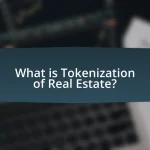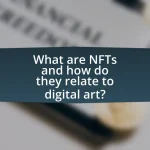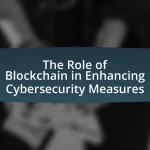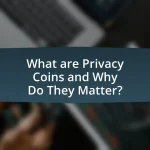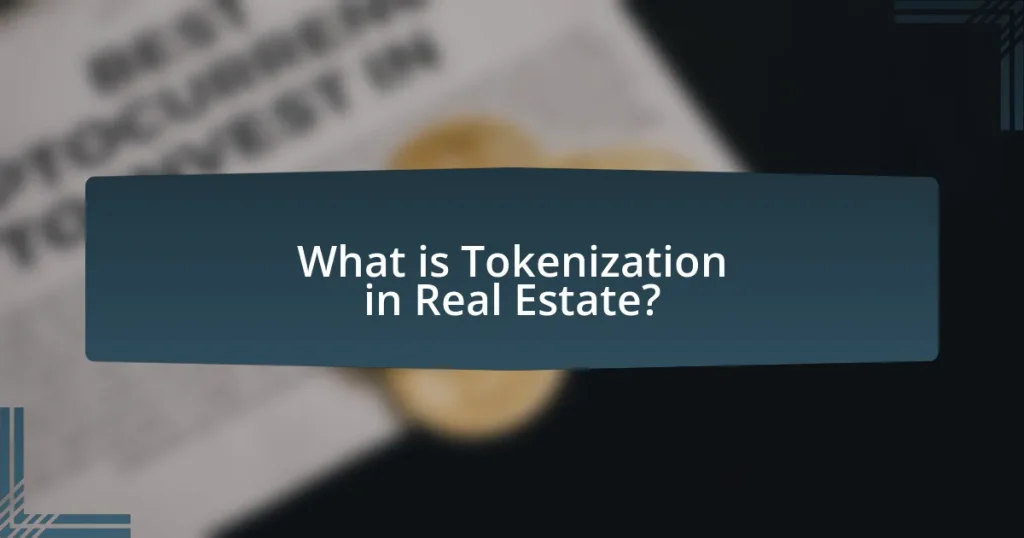Tokenization in real estate is the process of converting property ownership rights into digital tokens on a blockchain, facilitating fractional ownership and enhancing market liquidity. This article explores how tokenization transforms traditional real estate transactions by lowering barriers to entry, increasing accessibility, and streamlining processes. Key features of tokenized assets include enhanced liquidity and fractional ownership, which democratize investment opportunities. Additionally, the article examines current trends in tokenization across various sectors, the technological advancements driving these changes, and the regulatory challenges that must be addressed for successful implementation.

What is Tokenization in Real Estate?
Tokenization in real estate refers to the process of converting ownership rights in a property into digital tokens on a blockchain. This method allows for fractional ownership, enabling multiple investors to own a share of a property, thereby increasing liquidity and accessibility in the real estate market. According to a report by Deloitte, tokenization can reduce transaction costs and streamline processes, making real estate investments more efficient and transparent.
How does tokenization transform traditional real estate transactions?
Tokenization transforms traditional real estate transactions by converting physical assets into digital tokens on a blockchain, enabling fractional ownership and increased liquidity. This process allows investors to buy and sell shares of real estate properties easily, reducing barriers to entry and democratizing access to real estate investments. For instance, a property valued at $1 million can be tokenized into 1,000 tokens worth $1,000 each, allowing multiple investors to own a portion of the asset. Additionally, tokenization streamlines the transaction process by automating compliance and reducing the need for intermediaries, which can lower costs and speed up transactions.
What are the key features of tokenized real estate assets?
Tokenized real estate assets feature fractional ownership, enhanced liquidity, and increased accessibility. Fractional ownership allows multiple investors to own a share of a property, making real estate investment more affordable and diversifying risk. Enhanced liquidity is achieved through blockchain technology, enabling faster transactions and easier buying or selling of shares compared to traditional real estate markets. Increased accessibility is facilitated by lowering the minimum investment amounts, allowing a broader range of investors to participate in real estate markets. These features collectively transform how real estate is bought, sold, and owned, aligning with the growing trend of tokenization in various asset classes.
How does tokenization enhance liquidity in real estate markets?
Tokenization enhances liquidity in real estate markets by converting physical assets into digital tokens that can be easily traded on blockchain platforms. This process allows fractional ownership, enabling investors to buy and sell smaller portions of real estate assets, which increases the number of potential buyers and sellers in the market. As a result, properties that were previously illiquid can now be traded more readily, reducing the time and costs associated with traditional real estate transactions. For instance, a study by the World Economic Forum indicates that tokenization could increase liquidity in real estate markets by up to 30%, demonstrating its significant impact on market dynamics.
Why is tokenization gaining popularity in the real estate sector?
Tokenization is gaining popularity in the real estate sector primarily due to its ability to enhance liquidity and democratize access to investments. By converting real estate assets into digital tokens on a blockchain, investors can buy and sell fractional ownership, making it easier for a broader range of individuals to participate in the market. This shift is supported by the fact that traditional real estate investments often require significant capital, limiting participation to wealthier individuals. Tokenization lowers the entry barrier, allowing investments in properties with lower minimum amounts, thus expanding the investor base. Additionally, the transparency and security provided by blockchain technology further bolster investor confidence, contributing to the growing trend of tokenization in real estate.
What are the advantages of tokenization for investors?
Tokenization offers several advantages for investors, including increased liquidity, fractional ownership, and enhanced accessibility. Increased liquidity allows investors to buy and sell tokenized assets more easily on digital exchanges, which can lead to quicker transactions compared to traditional markets. Fractional ownership enables investors to purchase smaller portions of high-value assets, making it feasible for a broader range of investors to participate in markets that were previously out of reach. Enhanced accessibility is achieved through the use of blockchain technology, which can lower barriers to entry and facilitate investment from a global pool of investors. These advantages collectively contribute to a more inclusive and efficient investment landscape.
How does tokenization reduce barriers to entry for real estate investment?
Tokenization reduces barriers to entry for real estate investment by allowing fractional ownership, which enables smaller investors to participate in the market. This process divides real estate assets into digital tokens, representing shares of the property, thus lowering the minimum investment amount significantly. For instance, traditional real estate investments often require substantial capital, sometimes hundreds of thousands of dollars, while tokenized assets can be accessible for as little as a few hundred dollars. This democratization of investment opportunities increases liquidity and broadens the investor base, making real estate more inclusive.

What are the Current Trends in Tokenization Beyond Real Estate?
Current trends in tokenization beyond real estate include the tokenization of art, collectibles, and financial instruments. The art market is increasingly adopting tokenization to provide fractional ownership, allowing investors to buy shares in high-value artworks, thereby democratizing access to art investment. Additionally, collectibles such as sports memorabilia and trading cards are being tokenized, enabling secure ownership transfer and provenance tracking through blockchain technology. Financial instruments, including stocks and bonds, are also being tokenized to enhance liquidity and streamline trading processes, with platforms like tZERO and Securitize leading the way in this innovation. These trends reflect a broader movement towards digitization and accessibility in various asset classes.
How is tokenization being applied in other industries?
Tokenization is being applied in various industries such as finance, healthcare, and supply chain management. In finance, tokenization enables the creation of digital assets that represent ownership of real-world assets, facilitating easier trading and liquidity. For instance, companies like tZERO and Harbor are utilizing tokenization to offer fractional ownership of real estate and private equity, thus broadening access to investment opportunities. In healthcare, tokenization is used to secure patient data by converting sensitive information into tokens that can be safely shared without compromising privacy, as demonstrated by initiatives like the Health Information Trust Alliance. In supply chain management, tokenization enhances transparency and traceability by assigning unique tokens to products, allowing stakeholders to track their journey from production to delivery, as seen in projects by IBM and Maersk. These applications illustrate how tokenization is transforming traditional processes across multiple sectors.
What sectors are leading the way in adopting tokenization?
The sectors leading the way in adopting tokenization are real estate, finance, supply chain, and healthcare. Real estate is utilizing tokenization to enhance liquidity and fractional ownership, evidenced by platforms like RealT that allow property shares to be traded. The finance sector is leveraging tokenization for asset management and trading, with firms like Fidelity exploring tokenized assets for improved efficiency. In supply chain management, companies are adopting tokenization to enhance transparency and traceability, as seen in IBM’s Food Trust blockchain. Lastly, healthcare is implementing tokenization to secure patient data and streamline processes, with initiatives like MediLedger focusing on drug supply chain integrity.
How does tokenization impact supply chain management?
Tokenization significantly enhances supply chain management by improving transparency and traceability. By converting physical assets and transactions into digital tokens on a blockchain, stakeholders can track the movement of goods in real-time, reducing the risk of fraud and errors. For instance, a study by Accenture found that blockchain technology, which underpins tokenization, can reduce supply chain costs by up to 30% through improved efficiency and reduced delays. This increased visibility allows for better inventory management and more informed decision-making, ultimately leading to a more resilient supply chain.
What technological advancements are driving tokenization trends?
Technological advancements driving tokenization trends include blockchain technology, smart contracts, and decentralized finance (DeFi). Blockchain technology provides a secure and transparent ledger for recording transactions, which enhances trust and reduces fraud in tokenized assets. Smart contracts automate and enforce agreements without intermediaries, streamlining processes and reducing costs. Additionally, DeFi platforms facilitate liquidity and trading of tokenized assets, making them more accessible to a broader audience. These advancements collectively enable the fractional ownership of assets, democratizing investment opportunities and increasing market efficiency.
How do blockchain and smart contracts facilitate tokenization?
Blockchain and smart contracts facilitate tokenization by providing a secure, transparent, and automated framework for creating and managing digital assets. Blockchain technology ensures that each tokenized asset is recorded on a decentralized ledger, which enhances security and reduces the risk of fraud. Smart contracts automate the execution of agreements related to the tokenized assets, ensuring that transactions occur only when predefined conditions are met. This combination allows for fractional ownership, increased liquidity, and streamlined processes in various sectors, including real estate, where assets can be tokenized and traded more efficiently.
What role do regulatory frameworks play in the evolution of tokenization?
Regulatory frameworks play a crucial role in the evolution of tokenization by providing the legal structure necessary for the secure and compliant issuance and trading of digital assets. These frameworks establish guidelines that protect investors, ensure market integrity, and promote innovation within the tokenization space. For instance, the implementation of regulations such as the European Union’s Markets in Crypto-Assets (MiCA) proposal aims to create a unified regulatory environment across member states, thereby fostering trust and encouraging participation in tokenized markets. Additionally, regulatory clarity can enhance the legitimacy of tokenized assets, attracting institutional investors who require compliance with established laws before engaging in new financial technologies.

What are the Challenges and Considerations in Tokenization?
The challenges and considerations in tokenization include regulatory compliance, security risks, and technological limitations. Regulatory compliance is crucial as tokenized assets must adhere to existing laws, which can vary significantly across jurisdictions, complicating the issuance and trading processes. Security risks arise from potential vulnerabilities in smart contracts and blockchain technology, which can lead to hacks or fraud. Additionally, technological limitations, such as scalability issues and interoperability between different blockchain platforms, can hinder the widespread adoption of tokenization. These factors collectively impact the feasibility and effectiveness of tokenization in various sectors, including real estate.
What regulatory hurdles does tokenization face?
Tokenization faces significant regulatory hurdles primarily related to compliance with securities laws. In many jurisdictions, tokens representing ownership in assets may be classified as securities, requiring adherence to registration and disclosure obligations under laws such as the Securities Act of 1933 in the United States. Additionally, regulatory bodies like the SEC have issued guidance indicating that many token offerings must comply with existing securities regulations, which can complicate the issuance process. Furthermore, varying regulations across different countries create challenges for cross-border tokenization efforts, as companies must navigate a complex landscape of legal requirements that can differ significantly from one jurisdiction to another.
How do different jurisdictions approach tokenization regulations?
Different jurisdictions approach tokenization regulations with varying degrees of strictness and frameworks. For instance, the United States primarily views tokens as securities under the Securities and Exchange Commission (SEC) guidelines, requiring compliance with securities laws, while countries like Switzerland have established a more favorable regulatory environment, categorizing tokens based on their function and allowing for greater flexibility in their use. Additionally, Singapore has implemented a clear regulatory framework that encourages innovation while ensuring investor protection, demonstrating a balanced approach. These differences reflect each jurisdiction’s economic priorities, legal traditions, and regulatory philosophies, influencing how tokenization is integrated into their financial systems.
What compliance issues must be addressed for tokenized assets?
Tokenized assets must address compliance issues related to securities regulations, anti-money laundering (AML) laws, and data privacy requirements. Securities regulations are crucial because tokenized assets may be classified as securities, necessitating adherence to registration and disclosure obligations under laws such as the Securities Act of 1933 in the United States. Additionally, AML laws require that entities involved in the issuance and trading of tokenized assets implement robust customer due diligence processes to prevent illicit activities. Data privacy requirements, particularly under regulations like the General Data Protection Regulation (GDPR), mandate that organizations ensure the protection of personal data associated with token holders. These compliance issues are essential for mitigating legal risks and ensuring the legitimacy of tokenized asset offerings.
What risks are associated with tokenization in real estate and beyond?
Tokenization in real estate and beyond carries several risks, including regulatory uncertainty, cybersecurity threats, and market volatility. Regulatory uncertainty arises because the legal framework surrounding tokenized assets is still evolving, which can lead to compliance challenges and potential legal repercussions. Cybersecurity threats are significant as tokenized assets rely on blockchain technology, making them vulnerable to hacking and fraud. Market volatility is another risk, as the value of tokenized assets can fluctuate dramatically, impacting investor confidence and liquidity. These risks highlight the complexities and challenges associated with the adoption of tokenization in various sectors.
How can investors mitigate risks related to tokenized assets?
Investors can mitigate risks related to tokenized assets by conducting thorough due diligence on the underlying assets and the platforms facilitating the tokenization. This involves assessing the legal framework, understanding the asset’s valuation, and evaluating the credibility of the token issuer. For instance, a study by the World Economic Forum highlights that regulatory compliance and transparency are crucial in reducing risks associated with tokenized assets. Additionally, diversifying investments across various tokenized assets can help spread risk, as reliance on a single asset can lead to significant losses if that asset underperforms.
What are the potential pitfalls of investing in tokenized real estate?
Investing in tokenized real estate carries several potential pitfalls, including regulatory uncertainty, market volatility, and liquidity issues. Regulatory uncertainty arises because the legal framework surrounding tokenized assets is still evolving, which can lead to compliance risks and potential legal challenges. Market volatility is a concern as the value of tokenized real estate can fluctuate significantly based on broader cryptocurrency market trends, impacting investor returns. Additionally, liquidity issues may occur since tokenized real estate investments might not have a robust secondary market, making it difficult for investors to sell their tokens quickly or at a favorable price. These factors highlight the complexities and risks associated with this emerging investment avenue.
What best practices should be followed when engaging in tokenization?
When engaging in tokenization, it is essential to follow best practices such as ensuring regulatory compliance, implementing robust security measures, and conducting thorough due diligence. Regulatory compliance is crucial because tokenization often involves financial assets, which are subject to various laws and regulations; for instance, adhering to the Securities and Exchange Commission guidelines can prevent legal issues. Robust security measures, including encryption and secure key management, protect sensitive data and mitigate risks of cyber threats, as evidenced by the increasing number of data breaches in the financial sector. Additionally, conducting thorough due diligence on the underlying assets and the parties involved ensures transparency and reduces the risk of fraud, which is vital in maintaining trust in tokenized transactions.
How can investors evaluate tokenized real estate opportunities effectively?
Investors can evaluate tokenized real estate opportunities effectively by analyzing the underlying asset’s value, assessing the platform’s credibility, and reviewing the legal framework governing the tokenization. Evaluating the asset involves examining property location, market trends, and historical performance data to determine potential returns. Assessing the platform’s credibility includes researching the technology used, the team behind the project, and user reviews to ensure reliability and security. Reviewing the legal framework entails understanding the regulations surrounding tokenized assets, including compliance with securities laws and ownership rights, which can significantly impact investment safety and liquidity.
What strategies can enhance the success of tokenization projects?
To enhance the success of tokenization projects, implementing a clear regulatory framework is essential. A well-defined legal structure ensures compliance with local laws, which can mitigate risks and build trust among investors. For instance, jurisdictions like Switzerland have established guidelines for token offerings, fostering a secure environment for tokenization. Additionally, engaging stakeholders early in the process, including potential investors and regulatory bodies, can provide valuable insights and foster collaboration. Research indicates that projects with strong community involvement tend to achieve higher success rates, as seen in the case of the Real Estate Investment Token (REIT) initiatives that actively involved local communities. Lastly, leveraging robust technology platforms that ensure security and scalability can significantly enhance operational efficiency and user experience, as evidenced by successful blockchain implementations in various sectors.

